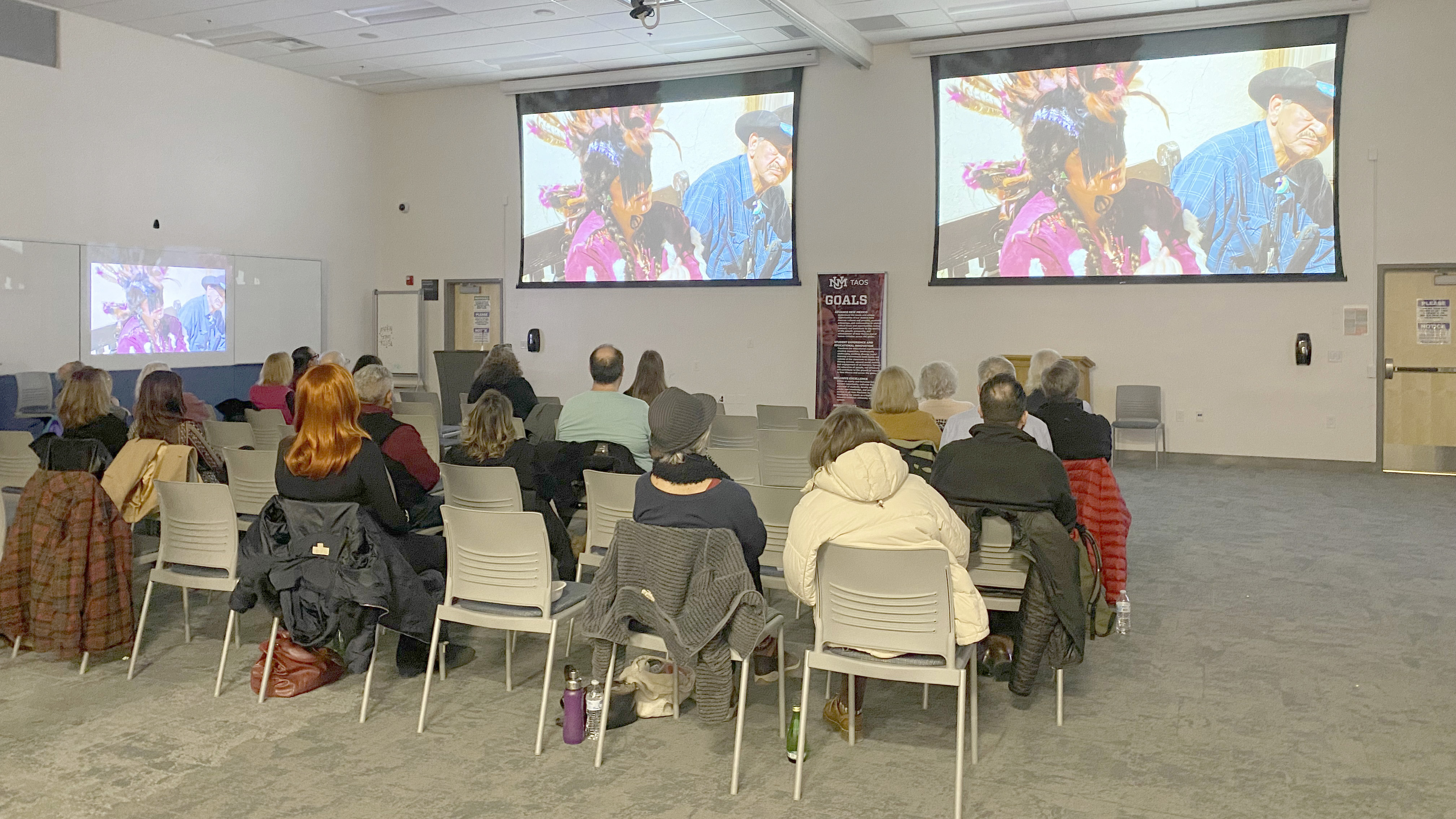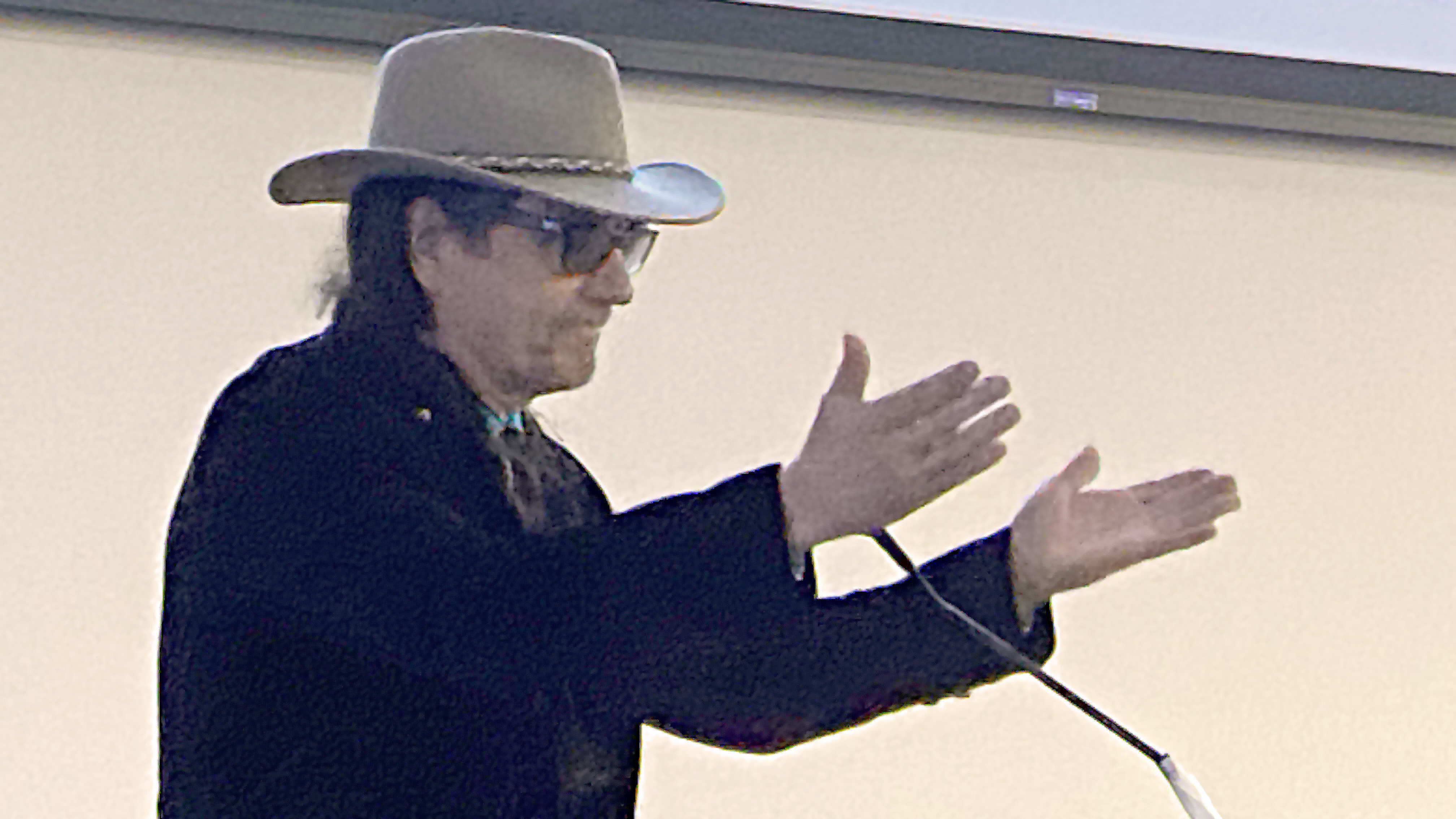Former UNM-Taos student’s documentary exposes, explores Indigenous slavery
January 30, 2024

Photo by Scott Gerdes
There are books about the Genízaros, but this is the first film about them. A screening of the hour-long documentary was held during a UNM-Taos Chancellor’s Circle event on Jan. 26 at Klauer campus.
Kidnapped. Held captive. Trained to be militants and servants. Forced into cultural integration. Auctioned as property. And it all happened in Northern New Mexico.
“The Genízaro Experience: Shadows in Light,” a 2022 documentary, delves deep into a lesser-known chapter of Northern New Mexico’s past, where the fates of enslaved Native Americans and objectives of Spanish colonists interweave from a time born out of violence and servitude.
This film offers a profound exploration of Indigenous enslavement, the Genízaros’ (Heh-nee-sah-ros) New Mexican narrative, and overarching themes such as cultural fusion, equity, genetic lineage, and tribal affirmation. It was written, produced, directed, and edited by Gary Medina Cook, a former UNM-Taos Film and Digital Media Arts (FDMA) student and Institute of American Indian Arts (IAIA) graduate and instructor. He is also an accomplished musician and composer.
“I opened myself up to spirit,” Medina Cook explained to the audience regarding the germination of his project. “I was led to create this film and tell this largely unknown story.”
The title, he said, came about because he felt like his ancestors were walking in shadows and light while they experienced trauma and sought their own identities.
There are books about the Genízaros, but this is the first film about them. A screening of the hour-long documentary was held during a UNM-Taos Chancellor’s Circle event on Jan. 26 at Klauer Campus, coordinated by Louis Moya, UNM-Taos director of Grants and Institutional Advancement.
Long before the transatlantic slave trade forced shackled African slaves onto American shores, Indigenous communities endured their own form of bondage. The aftermath of Christopher Columbus’s voyages witnessed the onset of such captivities, though officially declared illegal by the Spanish Queen. Despite this decree, explorers such as Hernán Cortéz exploited legal ambiguities to ensnare war and ransom captives. This practice persisted in New Mexico with controversial Spanish figures such as Juan de Oñate and Diego de Vargas.
The Pueblo Revolt of 1680 ushered in a detribalized labor/militia force, the Genízaros. Originally referred to as “war children,” they were seized and molded into militia to shield Spanish settlements during the 1700s. Indigenous women were also enslaved. Over time, the captives found themselves auctioned as commodities in Taos, Pecos, and Abiquiú Pueblos. Stripped of their heritage, they underwent forced assimilation becoming baptized, Christianized, and Hispanized.
By 1776, the Genízaros made up a significant third of New Mexico’s populace. Their resilience shone through as they navigated a complex identity, intertwining Indigenous and Hispanic cultures. Though many of their ancestral names faded into history’s tapestry, their indomitable spirit endures.
Medina Cook, the film’s visionary, brings a personal touch to this tale. A former Los Angeles musician, his familial roots stretch back to Northern New Mexico. He was raised in Santa Fe. His mother’s family is from the Taos/Questa area. His lineage traces back to the Genízaros.
Returning to Taos, he embarked on a journey of self-growth. His educational pursuits, from earning a High School Equivalency to studying at UNM-Taos and the IAIA in Santa Fe, reflect his dedication.
Highlighting the film—that debuted on New Mexico PBS last November and was also shown at numerous international film festivals, the Taos Center for the Arts, and the Santa Fe Film Festival—are musical contributions from Grammy Award-winners and nominees Robert Mirabal, Bill Miller, Rita Coolidge, and Michael Martin Murphey with poetic renditions from Joy Harjo. Mirabal and Murphey also contributed to the narrative. Special guest appearances include Raoul Max Trujillo from “Apocalypto” and the late Native activist John Trudell. Medina Cook’s documentary also showcases insights from artists, acclaimed authors, scholars, genetic genealogists, and present-day Genízaro descendants dedicated to preserving their multifaceted heritage. Rob Martinez, a distinguished state historian, lends his expertise to this compelling narrative.
Before the showing of “The Genízaro Experience: Shadows in Light,” UNM-Taos FDMA Program Coordinator Peter Walker introduced a few video production students and showcased their work, “Connections to the Land I: Voices of Acoma,” one of three completed pieces in the Native Voices Film Series. Produced by FDMA in conjunction with the Continental Divide Trail Coalition, the students have also completed the “Voices of Santa Clara” and the “Voices of Taos Pueblo.” The goal is to make documentaries of all the 19 New Mexico Pueblos and Hopi. Find out more at https://unmtaosfdma.com/native-voices-film-series/.
The UNM-Taos Chancellor’s Circle supports the college’s growth and aims to advance important initiatives on campus. The program honors the support of invested community members by creating a special group of ambassadors and donors for the college.
“Mr. Cook exemplifies the success stories that can emerge from UNM-Taos, having transitioned from a UNM-Taos student to a distinguished graduate of the IAIA, where he earned his BFA in Film with honors,” UNM-Taos Chancellor Mary Gutierrez, Ed.D., told the audience. “His awards and recognitions shine a light on the continued quality of his work, but also our Film Program, the caliber of our faculty, and the potential of our students.
“Film is important to New Mexico. Last fiscal year, $800 million was spent on film in New Mexico with a return investment of $8.4 million, meaning that every dollar spent on film generated $8.40 of economic impact. The film industry provides 8,000 jobs with an average crew wage of $35 per hour, fostering a fertile ground for our aspiring filmmakers. At UNM-Taos, we spare no effort in preparing our students for the coveted positions, ensuring they are equipped with both the technical prowess and artistic sensibilities necessary for success. However, for many of our students, unforeseen challenges such as changes in employment, housing, transportation, or childcare can jeopardize their academic progress. Your support can make all the difference, enabling our students to persist through emergencies and complete their goals.”
The efforts of the Chancellor’s Circle members support existing and new programming, scholarships, student enrichment projects, and the Student Emergency Fund. The Chancellor's Circle receives and shares news about the institution and the work UNM-Taos is doing in the community. Additionally, membership provides opportunities for member involvement on special projects for the campus and invitations to events that are available to only the Chancellor’s Circle. By gathering this important group, Chancellor Gutierrez hopes to encourage comradery, expertise, and advisement around the shared goal of excellence in higher education for Taos.
Find “The Genízaro Experience: Shadows in Light” at http://pbs.org/. See the film title under the top menu heading “Shows” then, “FROM NMPBS.”

